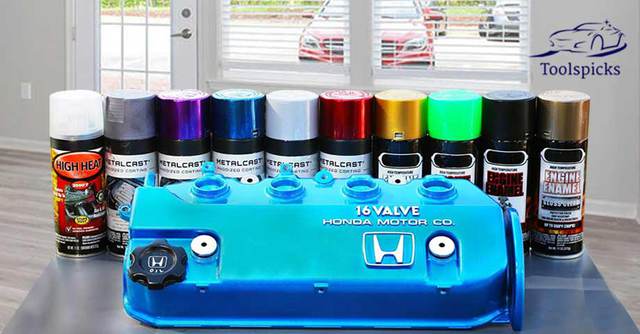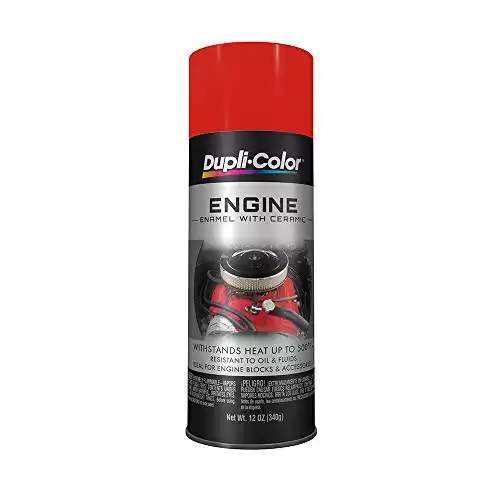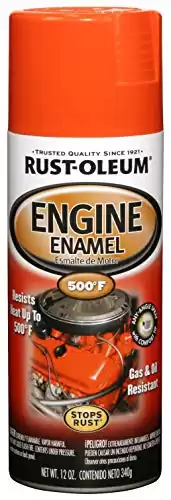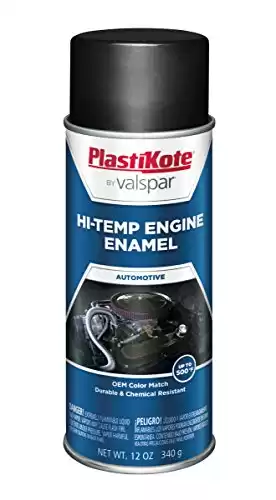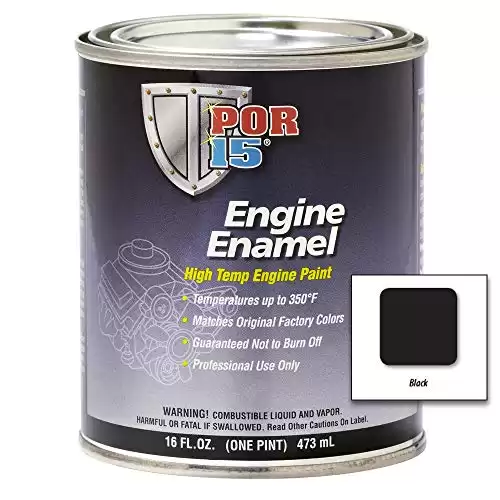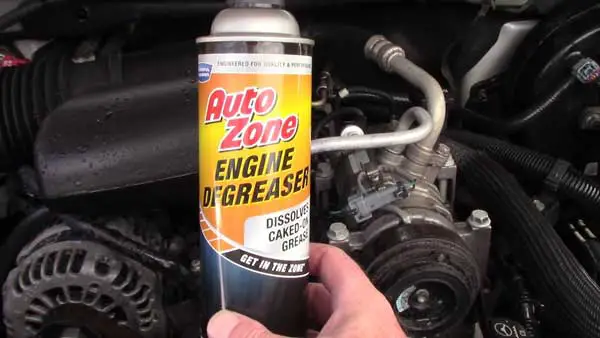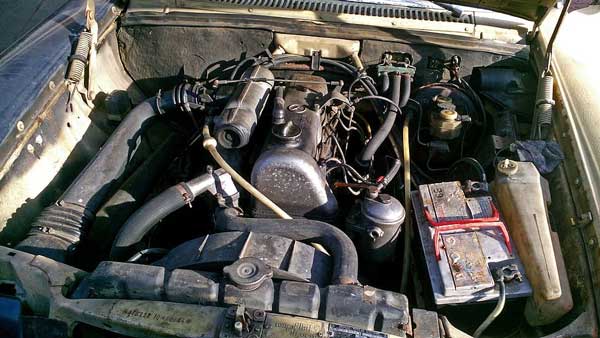High-quality engine paints tend to greatly enhance the presentation and appearance of a car’s engine. For this reason, most owners of show cars will happily spring for a habitual painting job on their engine blocks. This elevates their vehicles to another level together with the extra WOW factor which completes the overall presentation.
When most automotive engines are new, they feature a fine luster. However, that shine fades with time as the vehicle is used. Luckily, you can restore the ability of your engine to withstand various elements as well as its overall appearance.
The best and simplest way of coloring and keeping your engine new and shiny is by using engine enamel paints. Engine enamel paint serves 2 main purposes, that is, ensuring the engine looks good and keeping the rust out.
There are countless engine enamel paints in the market waiting for you to buy. But, which are some of the best engine paints? Getting an enamel paint that can shield and protect your engine from rust and corrosion isn’t that simple.
In this article, we’ve introduced our Top 3 engine paints that you can certainly depend on. These enamel paints have the quality of protecting and keeping your engine shine with a cool finish.
Continue reading this article and we’re certain that you’ll find the best enamel paint for your engine here. Moreover, you will learn about everything you need to know concerning engine enamel paints.
Our Picks
- Best Overall – Dupli-color Ceramic Orange engine paint
- Best Engine Paint –VHT SP155 Chrysler Red Single Engine EnameBuy on Amazon$12.49 ($1.14 / Ounce)We earn a commission if you make a purchase, at no additional cost to you.04/14/2024 07:51 am GMT
- Best Value – Rust-Oleum 248941 Engine Enamel
The Best Engine Paints 2022
1. VHT SP155 Engine Enamel
VHT is an acronym that simply means ‘Very High Temperature’. This indicates that VHT engine paints can withstand extremely high temperatures of up to 550°F.
The VHT formulation is among the most popular engine enamels which provide a high-quality finish and superior durability. In addition to boasting outstanding durability, these products provide superior resistance to most automotive chemicals and high heat.
Moreover, this formulation can protect the engine from environmental factors like gasoline additives, degreasers, rust, corrosion, salt, and chemicals. It’s worth noting that this formula dries in about 30 minutes. For this reason, it’s a great option if you don’t have several days to apply engine paint.
According to the website of the manufacturer, these enamels use a unique combination of ceramic resins and urethane. This blend ensures a durable finish under the harshest conditions that engines might encounter. However, to attain the unique properties of VHT enamel, ensure that it is heat cured properly. One way that you can cure this enamel is by baking the painted surfaces at 200°F. Additionally, you can cure this enamel with engine heat to help you save time.
It’s also worth noting that you can find this enamel paint in 31 various colors. Some of these colors include; GM, Chrysler, Pontiac, Chevy, and Ford. This ensures that you get a color that suits your requirements.
This VHT enamel paint comes in an 11 oz. spray can. The small capacity of this spray can indicate that you might need many spray cans. However, this engine paint is among the highest performing enamels and it’s easy to apply.
Pros
- Easy to apply spray paint
- Extremely high-temperature resistance
- Short drying time
- Resistant to various environmental factors
- Ceramic resin and urethane formulation
Cons
- Comes in a smaller can than most spray paint applications
2. Dupli-color Ceramic Orange engine paint
If you’re looking for an effective and affordable engine enamel, then we recommend that you choose this product. This Dupli-color engine paint includes impressive features, making it one of the best paint in the market. Its formula contains ceramic resins which allow for maximum heat retention and dissipation for its gloss finish.
Moreover, the resins offer protection against exposure to automotive fluids and temperatures of up to 500°F. This makes them ideal for most automotive engine applications.
Since this enamel is highly durable, it doesn’t crack, peel, flake, or blister. This makes it a popular option among most automotive enthusiasts. This engine enamel dries quickly. They dry after about 30 minutes of application and you can handle the painted parts after only 60 minutes.
The fact that this paint can be found in 28 colors makes it difficult for competitors to challenge its value. It comes in a 12 oz. can that has an EZ touch nozzle, making its spray application simple. Since this product is enamel paint, it can also be used for covering other metallic surfaces, making it extremely versatile.
To obtain the best final results, ensure that you heat the paint a bit so that it can cure properly. This is extremely easy to do with your engine because you only need to drive your car around a bit. However, on other applications, you can blast the enamel paint using the heat gun.
Even though this enamel paint is a great product for its price, you should remember its formula does not quite hold up on higher-quality surfaces. For instance, the formulation tends to wrinkle a little bit when you apply extra coats after more than 1 hour.
Pros
- Great heat dissipating properties
- Features a high gloss finish
- Easy to apply the spray paint
- Resistant to high temperatures and most automotive fluids like oil and gasoline
Cons
- A bit costly than most engine enamel paints
- It doesn’t specify protection from environmental factors like salt spray
3. Rust-Oleum Enamel Paint
This one is a durable enamel paint that will brighten your automotive engines with a glossy and smooth finish. I would rather call it a Rust-Oleum enamel paint. The formulation is resistant to environmental factors like rust, humidity, salt, solvents, grease, gas, and oil. It can withstand sporadic high temperatures of up to 500°F. Thus, It will certainly give you the best results on the engines.
Moreover, it will improve the aesthetics of your automotive engine.
Since its establishment in 1921, the Rust-Oleum brand has gained credibility and experience for its products. Another great thing with Rust-Oleum is that, unlike most competitor brands, you don’t have to heat cure them for durability. Nevertheless, you have to you’ve to let these enamel paints dry fully before subjecting them to extreme heat from engines. The main limitation of this Rust-Oleum enamel paint is that it may take about 1 week to cure completely.
This engine enamel comes in a collection of 15 various colors. Some of the most common colors include; Ford, Dodge, Chrysler, and Chevy. It comes packaged in a 12 oz bottle which has a comfortable tip spray nozzle.
The formulation of this engine enamel has been specifically designed for the engine and provides a durable finish. Even though it has a premium price for every can, it’s certainly a worthwhile investment. Overall its impressive features make it one of the best engine enamel.
Pros
- Durable smooth finish
- Made in the USA
- Convenient tip spray nozzle that can work from all angles
- It offers protection from environmental factors
Cons
- It requires about 7 days to dry and cure fully.
- Undesirable problems like blistering may occur if this paint is exposed to heat before it cures fully.
4. Plastikote Engine Enamel
Are you on the lookout for a versatile engine enamel that you can use on your engine as well as other surfaces? If your answer is yes, then you should probably consider this Plastikote engine enamel. You can use these enamel paints on wood, metal, and even on your automotive engine. It’s ideal for both outdoor and indoor projects. This makes it a great option for projects which use components of different materials but need the same color.
This enamel can withstand recurrent exposure to maximum temperatures of about 500°F. The best thing with this formulation is that it doesn’t peel, crack, lift or weaken when exposed to such high temperatures. Moreover, it offers sufficient resistance to both gasoline and oil.
However, the gloss finishes of these enamels are lower as compared to other engine paint enamels. For this reason, this might be appealing to some people, while others might consider other options. Plastikote enamel might not be the best enamel paint for motorcycles if you’re looking for high gloss finishes.
This engine enamel comes in a variety of 25 colors, including GM, Pontiac, Cummins, Chrysler, and Chevy among others. Its formulation is strong enough and ensures strong bonding as well as greater performance. Plastikote engine enamel is certainly the best solution for enhancing your engine if you’re looking for an excellent low gloss finish.
Pros
- This spray paint application is easy to use
- Resistant to most engine fluids like oil and gasoline
- Highly resistant to water and UV
Cons
- The spray can use a wide spray pattern, which might be more challenging to control accurately
5. POR-15 Engine Enamel
This is an engine enamel with a high-temperature formulation designed for professional uses. The best thing with POR-15 engine enamel is that it doesn’t burn off like the cheaper alternatives. POR-15 enamels are formulated by RestMotive Laboratories and contain additional pigment. The extra pigment provides the enamels with incredibly rich colors that flow easily and provides durable coverage to engines.
Additionally, these enamels are not flammable and they conform to the harshest environmental standards. These engine paints can withstand high temperatures of up to 350°F. Although this engine enamel is a bit expensive, these products cover a larger surface area than most engine enamel paints.
According to the manufacturer’s website, one pint is typically sufficient to paint an entire engine. Most colors of POR-15 enamel are found in pints, with the exception of the black and Chevy orange which are in quarts.
For simplicity and convenience, this enamel provides a complete kit for painting your engine. This painting kit comes included with POR-15 solvent, metal prep, cleaner degreaser as well as paint-brushes. Moreover, a safety face mask and latex surgical gloves are included to protect your lungs and skin while applying the enamel.
This engine enamel comes in 7 different colors, including white, chevy orange, Ford blue, and Olds Gold among others. The brush application of this enamel may be easier for some engine bays.
Pros
- Can be applied to other components of the engine
- Quarts or pint paint tins
- Durable finish
- Great surface area coverage
Cons
- Lower temperature resistance
- Brush application isn’t as simple as a spray application
- Long drying time (4 to 6 days)
How To Use Engine Paints Effectively?
Wipe down your engine
Before you apply the engine paint, ensure that you first wipe it down to remove dirt and loose particle. We suggest that you do this by sanding your engine thoroughly using a wire brush. This will help to remove debris as well as old paint. Moreover, clean the engine block using a wax remover and grease before you paint to remove chemicals and oil.
Begin with high heat enamel paint
This ensures uniformity in the top color coating and maximum resistance to corrosion. Then apply a primer and the topcoat enamel color using a light color first, thus avoiding sags and runs.
Spray applications
If you are using spray applicators, utilize long, sweeping motions uniformly when applying the enamel without it running. To get the best finish, we suggest that you apply 2 coats.
Apply more coats
Proceed to apply 2 more light coats and then apply a medium wet coat. This will help you to get better coverage as well as the smoothness of the finish. It’s also worth noting that fewer thinner coats provide high-quality coatings than 1 or 2 heavy coats. Additionally, you can top the paint using a clear coat. This will ensure that everything is sealed in and the paint doesn’t fade over time.
Wear a face mask
You should always remember to wear a face mask during the application of engine enamel paints. Moreover, you should ensure the area you’re working in is well ventilated. This helps in protecting your lungs from any harmful chemicals that may be contained in the engine paint. Similarly, wearing rubber gloves will protect your hands during paint application.
How Do I Prepare My Engine For Painting?
You might want to paint your engine block, especially when you’re rebuilding it. Painting the engine block serves certain purposes such as protection from rust and corrosion and providing a custom look. Moreover, it will make your engine look clean and aesthetically appealing.
The best way to paint your engine is when it’s completely disassembled. When the engine is painted while its components are still attached, you will not be able to clean it properly.
Additionally, the end product may be covered in overspray. Therefore, to enhance paint adhesion and prevent it from peeling off soon, it’s good to prepare the engine. This can be successfully achieved through the following steps;
Step 1: Disassemble your engine block completely
Remove the bolt-on components from your engine
This will include taking off the water pump, power steering pump, pulleys, and air intake manifold. Additionally, remove the cylinder heads, timing cover as well as any other remaining bolt-on part.
Remove the pistons and crankshafts
Unbolt and then remove all connecting rods and pistons from the engine.
Drain the engine fluids completely
Turn on the engine on every side and allow the fluids to drip out till they stop. You can then force the remaining fluids out using compressed air. Then wipe any loose oil using a rag and scrape off excess dirt with a wire brush or scraper.
Step 2: Degrease your automotive engine
Spray your engine with an aerosol degreaser.
Coat the engine completely with the degreaser spray and let it soak as per the manufacturer’s instructions.
Use clean water to rinse your engine completely
Spray the engine with a pressure washer or garden hose to get rid of the degreaser completely.
Remove water from the engine
After you complete rinsing the engine, use an air compressor to blow off water from the engine. This step is important, since the remaining water may cause rust or corrosion, especially if the engine has cast iron.
Check for grease or oil
This will help to ensure that you get rid of all the oil and grease from the exterior surface of the engine. If you notice any remaining spots of oil/ grease, re-apply degrease, rinse with water and remove the water once more.
Step 3: Cover the internal engine components
Mask the large areas with a newspaper
Cover the areas that shouldn’t be painted with a newspaper. One such area is the mounting surface of the cylinder head. For extra strength, use 2 layers to cover the surfaces and put tape around the edge of the paper.
Cover small bolt holes
You can either insert old bolts or tape them into bolt holes to prevent the paint from getting in the threads. Similarly, use masking tape to wrap manifold studs.
Check the engine again
Check the entire engine again and ensure that all openings in the engines have been covered. If you spot any, cover it with a newspaper or tape.
Step 4: Remove the loose and old paint from the engine’s surface
For the paint to adhere to the engine for a long time, it should be free from any loose paint. Therefore, you should remove the loosened paint using a media blaster.
Fill the media blaster’s hopper with media
Using soda media helps to clean the paint on the engine. Soda media is a great medium for removing corrosion and paint from the engine block. It’s abrasive yet sufficiently soft to avoid damaging critical internal components of the engine.
Turn on the compressor after attaching the media blaster
However, you should ensure that you wear a face mask and eye protection during this process.
Start using the media blaster on the engine
Point the blaster’s nozzle at your engine and pull its trigger. Soda media then blasts away rust and loose paint from the engine to expose the metal surface underneath. Continue using the blaster until all the loose materials and paint is removed from the engine completely. However, you should stop occasionally to refill the hopper or allow the air compressor to recharge.
Apply vinegar on the engine
Fill the spray bottle with water and vinegar, one cup for each. Then spray the entire surface of the engine with the solution to neutralize soda media.
Dry the engine surface
Use an air compressor to dry the engine surface and it will now be ready to receive the first coat of engine paint. However, you should apply the paint instantly or after a couple of hours. Taking more time will cause the engine surface to rust again.
Things To Consider When Buying The Best Engine Paints
Painting & Drying time
This is the first factor that you should put into consideration when buying the best engine enamel paints. Moreover, you should adhere to the painting and drying time to ensure the layers bond to one another appropriately. This will also help you determine the time the paint takes to cure fully to enhance surface durability.
Some enamel paints tend to dry quickly, about 30 minutes while others may take even days. For this reason, you should check the instruction offered by every manufacture before you settle for a certain product. This will ensure that you choose an engine paint that meets all your requirements.
Chemical Composition/ Formulation
It’s also important to note the impact the engine paint has on the environment based on its chemical composition. Most engine paints have similar base ingredients. They are mostly differentiated by the additives. However, there are some brands that include unpleasant compounds that are currently banned. Since most ingredients of the formulation aren’t included in product descriptions, it’s good to check with the product’s manufacturer.
Application
Most engine paints are either supplied as brush-on liquids or in spray cans. The spray cans are easy and quick to use since you only need to shake and apply. Moreover, some spray cans have nozzles that can either spray upside down or sideways.
On the other hand, brush-on enamels consume a lot of time to apply, although they generally provide better coverage. Therefore, this is another factor that you should consider before buying and choose the one that suits your needs perfectly.
Heat resistance
Most engine paints have been rated to withstand maximum temperatures of up to 500°F. On the other hand, there are other paints that can be able to withstand even higher temperatures, sometimes about 2000°F. However, an average automotive engine doesn’t produce temperatures that are even close to that range. Therefore, buying an engine enamel with such extra heat resistance is not necessary.
Frequently Answers Questions
1. What is the best heat-resistant paint?
Rust-Oleum Specialty spray paint is currently the best heat-resistant paint on the market. It comes in a 12 oz. spray can and can retain its finish and color up to a maximum temperature of 1200°F.
2. Does engine paint need a primer?
Yes and No. This depends on what you’re looking for as well as the durability you are seeking. For instance, if you want the paint to last, we suggest that you at least use the topcoat. Additionally, you will need to prepare the area properly. Similarly, using the engine primer increases longevity even further.
3. What is VHT Paint? Is VHT engine paint any good?
The acronym, VHT, simply stands for Very high temperature. VHT paint is, therefore, an enamel paint that has superior resistance to extremely high temperatures and chemicals. Additionally, VHT paints have excellent durability.
According to experts, 3 main characteristics of enamel paints including; gloss resistance, heat retention, and resistance to flaking and chipping. Therefore, VHT paint is a good engine paint since it meets most of those characteristics.
4. What type of paint is heat resistant?
Enamel paint is the name that refers to high heat or heat resistant paints and they’re used for various applications. For instance, they’re used for flame control and heat protection. It’s also worth noting that various brands of enamel paints have different characteristics and heat tolerance. Additionally, enamel paints either come in spray cans or brush on cans.
5. What is the engine enamel?
Engine enamel is a paint that air-dries to leave a glossy finish. It is mainly used to coat outdoor surfaces as well as surfaces that are subjected to temperature variations or hard wear.
6. How do you powder coat an engine?
Powder coating is very durable and protects the metallic components of your engine from rust. The main types of powder coating include Polyester and epoxy powder coating. Regardless of the type of powder coating you choose, you’ll need a media blaster to remove the loosened paint. Once you’ve media blasted the engine surface, shoot the coating powder on the surface. Then place it in an oven for about 20 minutes, remove it and let it cool. The best thing about powder coating is that it provides excellent outdoor durability and wear resistance.
Hope this guide helps you to choose the best engine paint. Best of luck!

Myself Erick R. Jackson, I am a Computer Science graduate by law but a passionately enchanted blogger by profession.
A few years back, it all started with my first blog website. It was about to deal and heal with automotive hand tools. Well, it brought me a good audience base for sure, which then dragged me out of my major and got me to sit and write, and be a blogger. Read more

